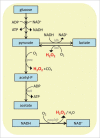Pathogen control at the intestinal mucosa - H2O2 to the rescue
- PMID: 28080210
- PMCID: PMC5341913
- DOI: 10.1080/19490976.2017.1279378
Pathogen control at the intestinal mucosa - H2O2 to the rescue
Abstract
Intestinal infections are a global challenge, connected to malnutrition and inadequate hygiene in developing countries, and to expanding antibiotic resistance in developed countries. In general, a healthy host is capable of fighting off gut pathogens or at least to recover from infections quickly. The underlying protective mechanism, termed colonization resistance, is provided by indigenous commensal communities (microbiota) that are shaped and aided by the host's epithelial and innate immune system. Commensal-pathogen interactions are governed by competition for a suitable niche for replication and stable colonization, nutrient availability, species-specific alterations of the metabolic environment, changes in oxygen tension and release of chemicals and proteinaceous toxins (bacteriocins). This protective intestinal milieu is further reinforced by antimicrobial factors and chemicals secreted by the epithelial barrier, by dendritic cell sensing and by homeostasis between T-cell subsets (Treg/Th17) in the lamina propria. The 3 players (host-microbiota-pathogen) communicate via direct interactions or secreted factors. Our recent manuscript illustrates that reactive oxygen species (ROS) are an integral part of colonization resistance and should be considered an interkingdom antivirulence strategy.
Keywords: C. rodentium; LEE pathogenicity island; NADH flavin Reductase; NADPH oxidase; antivirulence; defensive symbiosis; lactobacilli; reactive oxygen species (ROS).
Figures
References
-
- Holland SM. Chronic granulomatous disease. Hematology/oncology clinics of North America 2013; 27:89-99, viii; PMID: 23351990; http://dx.doi.org/10.1016/j.hoc.2012.11.002 - DOI - PMC - PubMed
-
- Kim SH, Lee WJ. Role of DUOX in gut inflammation: lessons from Drosophila model of gut-microbiota interactions. Front Cell Infect Microbiol 2014; 3:116; PMID: 24455491; http://dx.doi.org/10.3389/fcimb.2013.00116 - DOI - PMC - PubMed
-
- Grasberger H, Gao J, Nagao-Kitamoto H, Kitamoto S, Zhang M, Kamada N, Eaton KA, El-Zaatari M, Shreiner AB, Merchant JL, et al.. Increased Expression of DUOX2 Is an Epithelial Response to Mucosal Dysbiosis Required for Immune Homeostasis in Mouse Intestine. Gastroenterology 2015; 149:1849-59; PMID: 26261005; http://dx.doi.org/10.1053/j.gastro.2015.07.062 - DOI - PMC - PubMed
-
- Leoni G, Alam A, Neumann PA, Lambeth JD, Cheng G, McCoy J, Hilgarth RS, Kundu K, Murthy N, Kusters D, et al.. Annexin A1, formyl peptide receptor, and NOX1 orchestrate epithelial repair. J Clin Invest 2013; 123:443-54; PMID: 23241962; http://dx.doi.org/10.1172/JCI65831 - DOI - PMC - PubMed
Publication types
MeSH terms
Substances
LinkOut - more resources
Full Text Sources
Other Literature Sources

